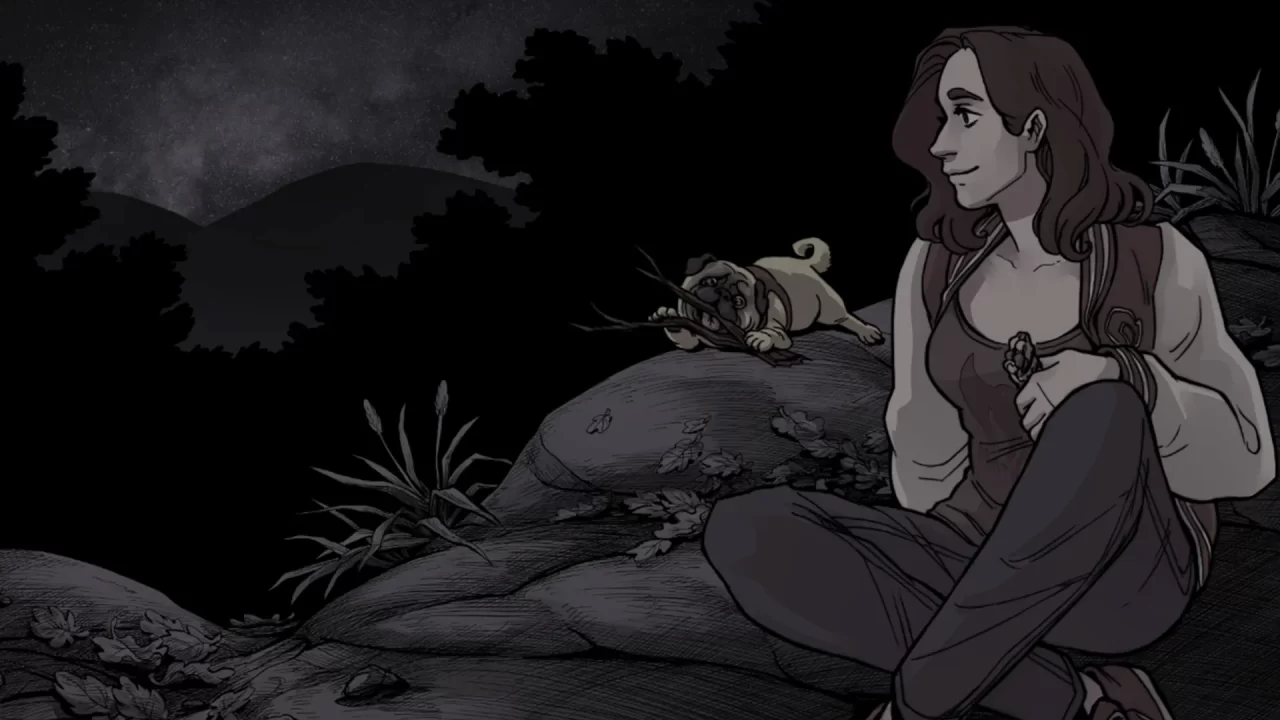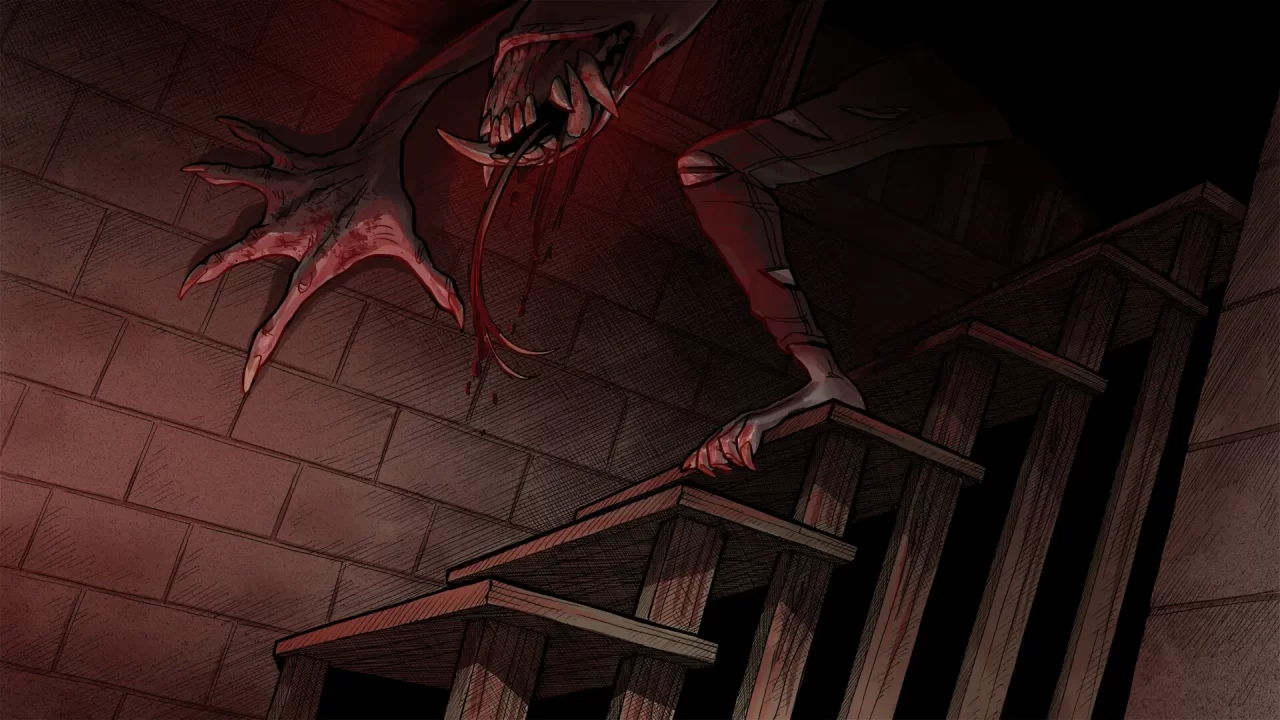Small towns are scary, and they’re trying to kill you.
Those who didn’t grow up in a small town might think that’s ridiculous, but if you have, you know better. You know the horrors of walking through the night with no streetlights. Or suspecting that the forest behind the old elementary school is inhabited by malevolent creatures. Or knowing the abandoned house in the hills is haunted. These small-town myths, passed from generation to generation, offer a rich vein of potential horror for TV shows like Twin Peaks and Stranger Things or video games like Alan Wake or Silent Hill. But few games capture this small-town “charm” as effectively as the episodic visual novel Scarlet Hollow. It genuinely might be one of the best examples of small-town horror I have ever experienced (apart from growing up in one myself).
Welcome to Scarlet Hollow, a rural town founded by your estranged family, the Scarlets. Despite having never met you, you receive an invitation from your cousin Tabitha one day requesting you attend your aunt’s funeral. After dropping you off at your crumbling ancestral homestead, Tabitha, barely acknowledging your presence, abandons you to explore on your own. It isn’t long before a charming cryptid-hunting YouTuber named Stella and her geriatric pug, Gretchen, (likely) pulls you along on a light-hearted expedition into the forest to find the legendary cryptid Skunk Ape. However, things quickly turn much more horrifying when you discover malformed, slug-like creatures called Ditchlings lurking in the dark, infesting animals (and possibly humans) to use them as incubators. You (likely) escape, but this is just the start of your week in Scarlet Hollow…
The two-person team at Black Tabby Studios, Abby Howard and her husband Tony Howard-Arias, are probably best known for the existential horror visual novel Slay the Princess, but Scarlet Hollow was their very first project. Black Tabby released the first four of seven planned episodes between 2020 and 2023 to critical acclaim, but rather than moving straight into episode five, Black Tabby decided to revisit their earlier episodes, like they did with Slay the Princess – The Pristine Cut. This new version, called The Roads Untraveled, expands the story, adds over 70,000 words of text, improves the UI, and redraws and polishes the game’s already stunning art. If there was ever a time to try Scarlet Hollow, it’s now.
Anyone who’s played Slay the Princess will instantly recognize Abby Howard’s art style in Scarlet Hollow, but there are differences. Princess had an ethereal, dreamlike quality, with everything looking like a pencil sketch. Hollow features a similar hand-drawn look but with sharper, defined lines. Rather than the stark black and white of Princess, the detailed backgrounds and characters here are rendered in a muted, low-saturation palette with occasional splashes of subtle colour. Abby’s extraordinary talent for depicting the grotesquely beautiful is on full display here. From the unsettling creatures in the woods to ghostly horrors beyond understanding, she illustrates everything with such loving detail that you can’t help but admire their beauty even as they repulse you.
In many visual novels, including my beloved Ace Attorney series, character portraits usually remain identical throughout the entire game. Here, there are unique portraits for every character in each episode as characters change their clothes or show the exhaustion of the previous day’s trials on their faces. Though labour-intensive, this extra level of detail sets Hollow apart from many other VNs and adventure games. The stunning animated sequences that bookend each episode are also worth mentioning. The team animates these in the same style as the rest of the game, but the addition of a moving camera adds a new twisted perspective to the art.
Hollow‘s visual style perfectly complements the writing, and, my God, what wonderful writing it is. Abby and Tony Howard-Arias have done a truly authentic job of capturing life in a small, decaying town. From the local café where everyone gathers to the site of the town’s only industry, the Scarlet Mines, Scarlet Hollow feels like a real place with a long and, frankly depressing, history. The writing also excels in handling the branching narratives. I can only imagine how difficult it would be to keep track of the dozens upon dozens of story permutations, but Abby and Tony seem to pull it off effortlessly (although I imagine a massive conspiracy board in their office with several sweaters’ worth of yarn tying together the countless plot threads).
To choose an example from the expanded first episode, I joined Stella and Gretchen for the hunt in the woods in my first run-through. While there, we ran into what seemed like an incidental character, an old man named Duke, who was quickly, uh, “written out” of the story. In my second playthrough, avoiding the woods led to Duke saving me from a Ditchling-infested mountain lion. I ended up having a lengthy conversation with him, reshaping my impression of the character (and making the big choice at the end of episode one much more gut-wrenching). Moments like these encourage multiple playthroughs to see the many versions of the story and character relationships.
The relationship system in Scarlet Hollow is shockingly expansive in scale, reminding me of Mass Effect in how your choices impact the way characters interact with you. For example, your cousin Tabitha may start as abrasive but could gradually transform into a more sympathetic, even slightly lovable character. Alternatively, her antipathy could shift into white-hot hatred, reigniting the long-standing rivalry between your two sides of the family. It’s rare to see a non-antagonistic main character written as this intentionally unlikable, but all of her actions feel fully motivated and justified. Another standout character is Stella, the chipper YouTuber with a dark secret. Her enthusiasm for the supernatural goings-on in town is delightful, often driving the plot forward. There are so many others I could mention: Kaneeka, the goth shopkeeper who wants out of town; Reese, the sickly shut-in under the thumb of his overprotective mother; and Avery, the hot and stylish waiter at the café looking to make some new friends. And best of all, many of these characters are romanceable!
If I have a pet peeve about visual novels, it’s that your choices often don’t matter. There may be several possibilities for what to do, but they all lead to nearly the same outcome. That isn’t the case with Scarlet Hollow. Player agency matters here in a big way, and the sheer number of paths the story can take is breathtaking. Even more impressive: no matter which outcome you get, it always feels like this was how the story was supposed to unfold.
The first major decision you make in the game involves selecting your character traits from seven options, including Book Smart, Hot, Mystical, and others. These traits don’t just unlock different conversational paths, they also significantly influence how other characters interact with you. For example, picking the Hot trait will have all the supporting characters drooling over you, opening up the possibility of developing romantic attachments much faster. Book Smart allows you to dig deeper into the lore and history of Scarlet Hollow at the library. Meanwhile, Animal Friend unlocks an entire subplot involving the dog militia of Scarlet Hollow! This trait system ensures that no two runs of Scarlet Hollow will ever feel the same, further increasing the replay value.
Though Steam labels Scarlet Hollow as Early Access, I don’t necessarily think that label fully applies here. The overarching story may have three episodes to go, but the game never feels feature-incomplete. By the end of episode four, I felt like I’d seen a cliffhanger at the end of a favourite television series rather than hitting a wall of unfinished content. And if I can handle Commander Riker gravely ordering, “Mr. Worf, fire,” I can handle waiting for episode five. Based on the first four episodes, I am sure they will stick the landing (unlike BOBW Part 2).
I loved Slay the Princess, but truthfully enjoyed Scarlet Hollow even more. The sheer number of story permutations and complex character relationships offer a replay value I’ve rarely seen in a VN. I’ve only completed two playthroughs, but I will be returning for another few runs before the next episode. Black Tabby Games has created something special that all adventure game and VN fans should experience, even if they don’t love horror. Yes, Scarlet Hollow is technically a horror game, but it’s not full of jump scares or cheap thrills. Instead, it gently pulls you into the world of this small, decaying town, allowing you to experience the rot within. By my fourth day in the game, I realized I didn’t want to leave Scarlet Hollow. It’s the first time I’ve ever been content in a small town, and if that isn’t a testament to the quality of this wonderful, terrifying game, nothing could be!






